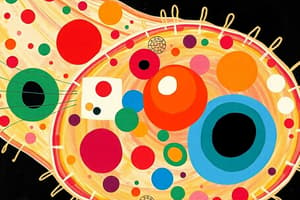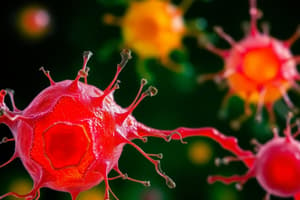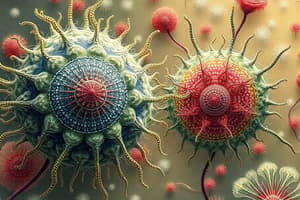Podcast
Questions and Answers
Which structure is primarily responsible for controlling what goes in and out of the cell?
Which structure is primarily responsible for controlling what goes in and out of the cell?
- Cytoplasm
- Cell membrane (correct)
- Centrioles
- Cell wall
The cell wall is found in all eukaryotic cells.
The cell wall is found in all eukaryotic cells.
False (B)
What is the primary role of chloroplasts in plant cells?
What is the primary role of chloroplasts in plant cells?
Photosynthesis
The jelly-like substance inside a cell, excluding the nucleus in eukaryotic cells, is called the ______.
The jelly-like substance inside a cell, excluding the nucleus in eukaryotic cells, is called the ______.
Match the following organelles with their functions:
Match the following organelles with their functions:
Which type of cells contain centrioles?
Which type of cells contain centrioles?
Cytoplasm is exclusive to eukaryotic cells.
Cytoplasm is exclusive to eukaryotic cells.
What is the significance of the cell wall for prokaryotic and some eukaryotic cells?
What is the significance of the cell wall for prokaryotic and some eukaryotic cells?
What is the primary function of the rough endoplasmic reticulum (ER)?
What is the primary function of the rough endoplasmic reticulum (ER)?
The Golgi apparatus is involved in the synthesis of proteins.
The Golgi apparatus is involved in the synthesis of proteins.
What is the main role of mitochondria in eukaryotic cells?
What is the main role of mitochondria in eukaryotic cells?
Lysosomes contain enzymes that break down ______ within the cell.
Lysosomes contain enzymes that break down ______ within the cell.
Which type of vacuole is typically larger in plant cells?
Which type of vacuole is typically larger in plant cells?
Ribosomes are found in both prokaryotic and eukaryotic cells.
Ribosomes are found in both prokaryotic and eukaryotic cells.
What does the nucleus do?
What does the nucleus do?
Flashcards
What is the cell membrane?
What is the cell membrane?
The outer layer of all cells, controlling what enters and exits.
What's the cell wall's function?
What's the cell wall's function?
Found in most prokaryotes and some eukaryotes, it provides structural support and protection.
What are centrioles and what do they do?
What are centrioles and what do they do?
Found in animal cells, they are involved in cell division by forming spindle fibers.
What is a chloroplast, and what does it do?
What is a chloroplast, and what does it do?
Signup and view all the flashcards
What is cytoplasm?
What is cytoplasm?
Signup and view all the flashcards
Why is the cell membrane important?
Why is the cell membrane important?
Signup and view all the flashcards
What is the purpose of the cell wall?
What is the purpose of the cell wall?
Signup and view all the flashcards
What is the role of centrioles in cell division?
What is the role of centrioles in cell division?
Signup and view all the flashcards
Endoplasmic Reticulum (ER)
Endoplasmic Reticulum (ER)
Signup and view all the flashcards
Golgi Apparatus
Golgi Apparatus
Signup and view all the flashcards
Lysosome
Lysosome
Signup and view all the flashcards
Mitochondrion (plural: mitochondria)
Mitochondrion (plural: mitochondria)
Signup and view all the flashcards
Nucleus
Nucleus
Signup and view all the flashcards
Ribosome
Ribosome
Signup and view all the flashcards
Vacuole
Vacuole
Signup and view all the flashcards
Study Notes
Cell Membrane
- Found in all cells (prokaryotic and eukaryotic)
- External layer of the cell
- Important for controlling what goes in and out of the cell
- Crucial for maintaining homeostasis
Cell Wall
- Found in most prokaryotic cells and some eukaryotic cells (e.g., plant cells)
- Important for structural support
- Provides additional protection to the cell
- Helps maintain the cell's shape
Centrioles
- Found in eukaryotic cells (e.g., animal cells)
- Not found in plant cells
- Derived from the centrosome
- Two centrioles per centrosome
- Involved in cell division, specifically the formation of spindle fibers
Chloroplast
- Found in eukaryotic cells (e.g., plant cells)
- Not found in animal cells
- Responsible for photosynthesis
- Produces sugar
Cytoplasm
- Found in all cells (prokaryotic and eukaryotic)
- Everything inside the cell except for the nucleus in eukaryotic cells.
- Includes cytosol, a jelly-like substance.
- Supports the organelles along with the cytoskeleton
Endoplasmic Reticulum (ER)
- Found in eukaryotic cells (both plant and animal cells)
- Folded structure that acts as a highway for materials within the cell
- Plays a role in processing molecules
- Two types:
- Rough ER: Contains ribosomes and makes proteins
- Smooth ER: Makes lipids and is involved in detoxification
- Vesicles transport materials from the ER to other organelles
Golgi Apparatus
- Found in eukaryotic cells (both plant and animal cells)
- Acts like a packaging facility
- Modifies, sorts, and packages materials for delivery within the cell
Lysosome
- Found in eukaryotic cells (typically animal cells)
- Contains enzymes that break down substances
- Involved in digestion within the cell
- Potential for breaking down pathogens
Mitochondrion (plural: mitochondria)
- Found in eukaryotic cells (both plant and animal cells)
- Responsible for cellular respiration
- Produces ATP (adenosine triphosphate), the energy currency of the cell
Nucleus
- Found in eukaryotic cells (both plant and animal cells)
- Contains the cell's DNA
- Controls the cell's activities
Ribosome
- Found in all cells (prokaryotic and eukaryotic)
- Responsible for protein synthesis
Vacuole
- Found in eukaryotic cells (both plant and animal cells)
- Stores materials depending on the cell type
- Large central vacuole in plant cells
- Smaller, multiple vacuoles in animal cells
- Stores water, proteins, and waste products.
Studying That Suits You
Use AI to generate personalized quizzes and flashcards to suit your learning preferences.




